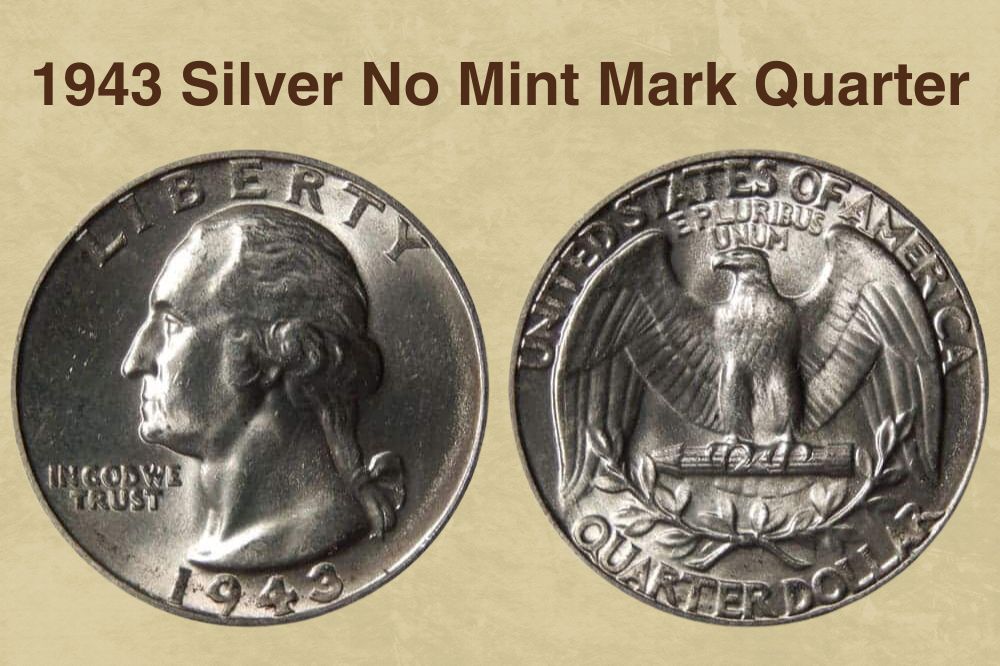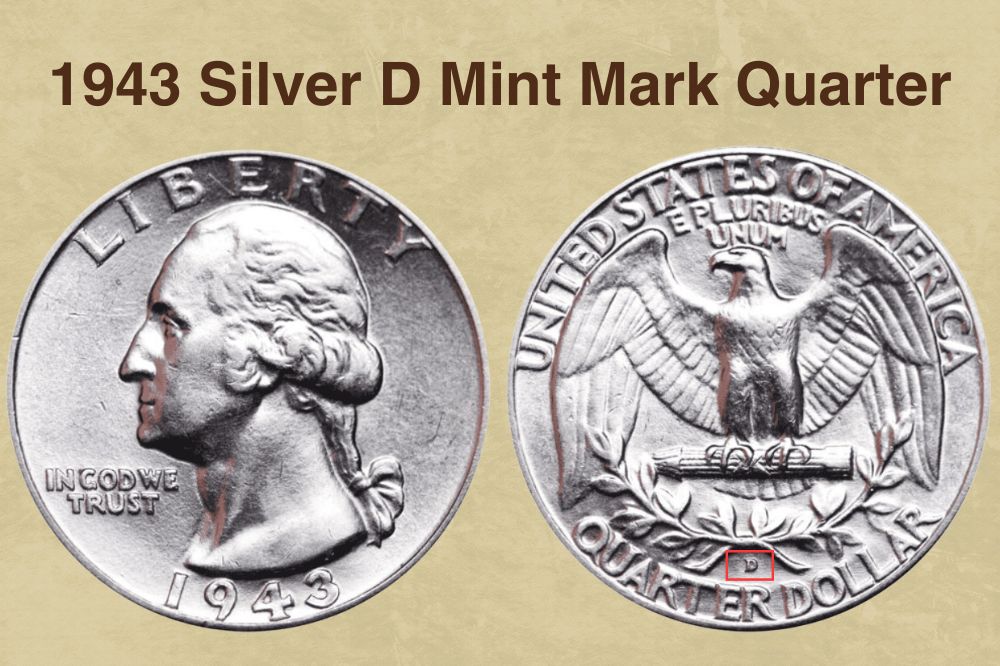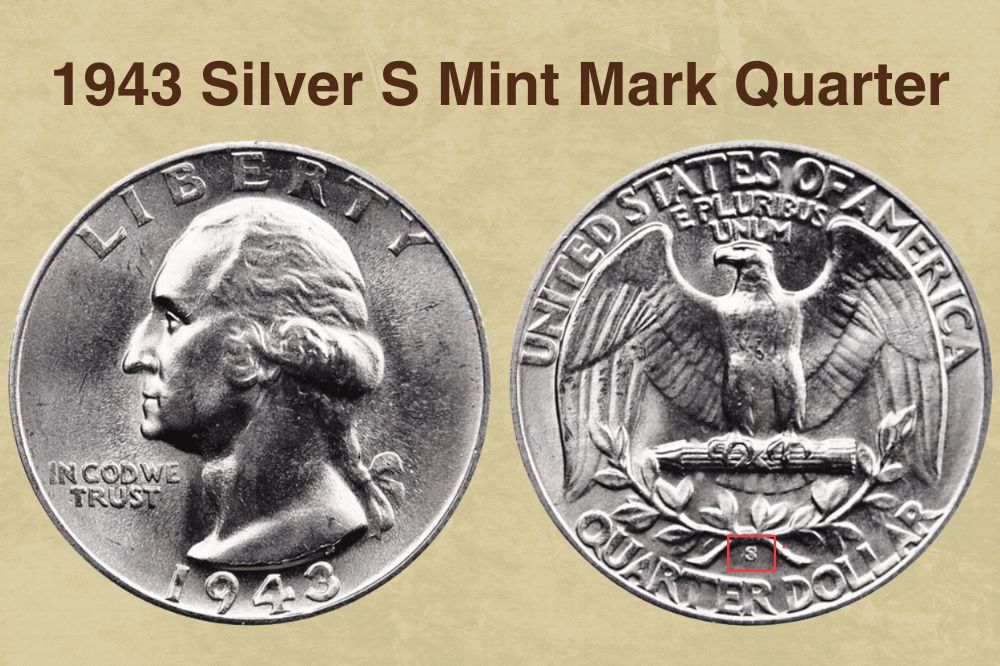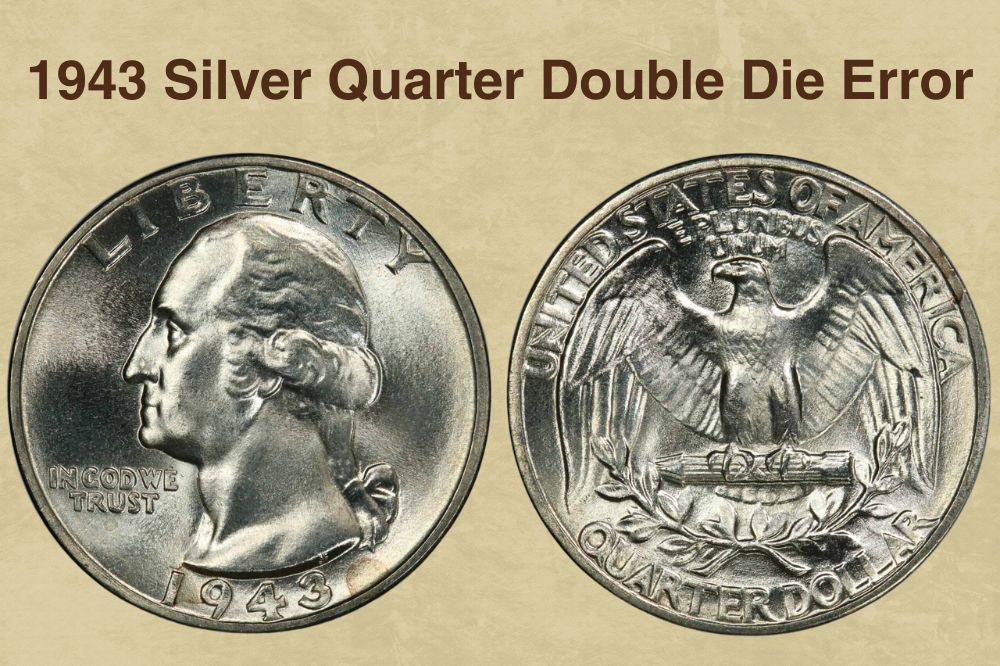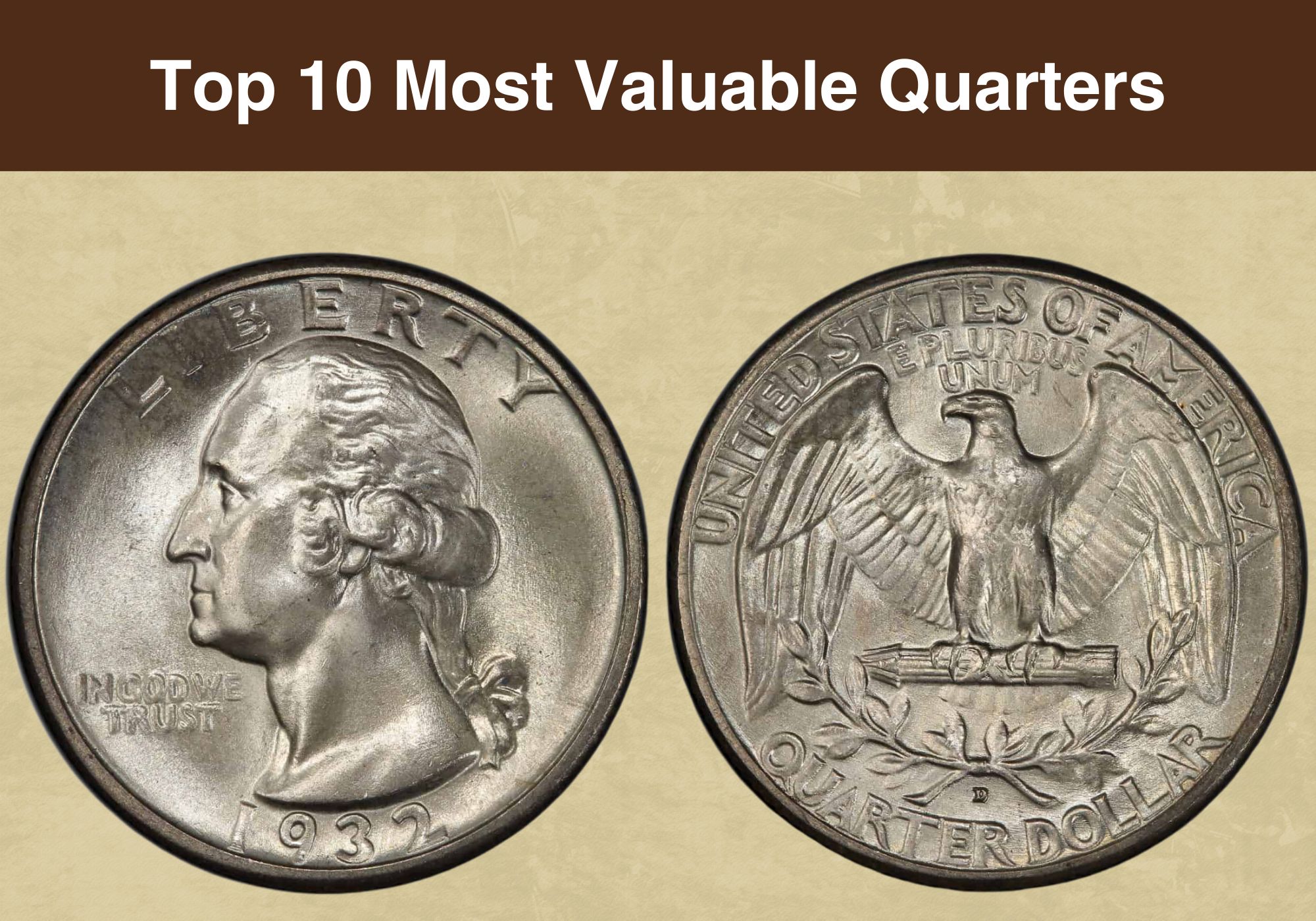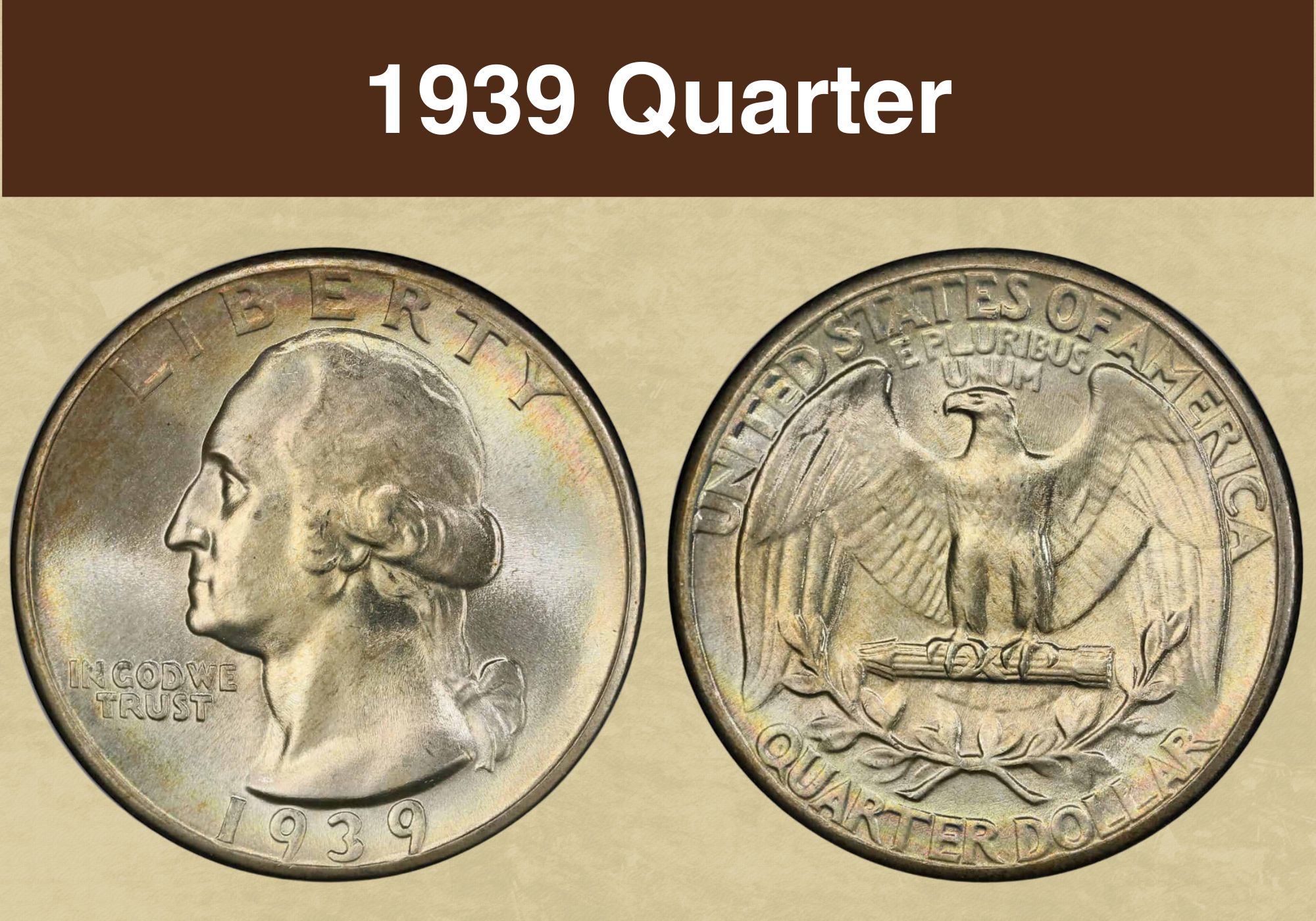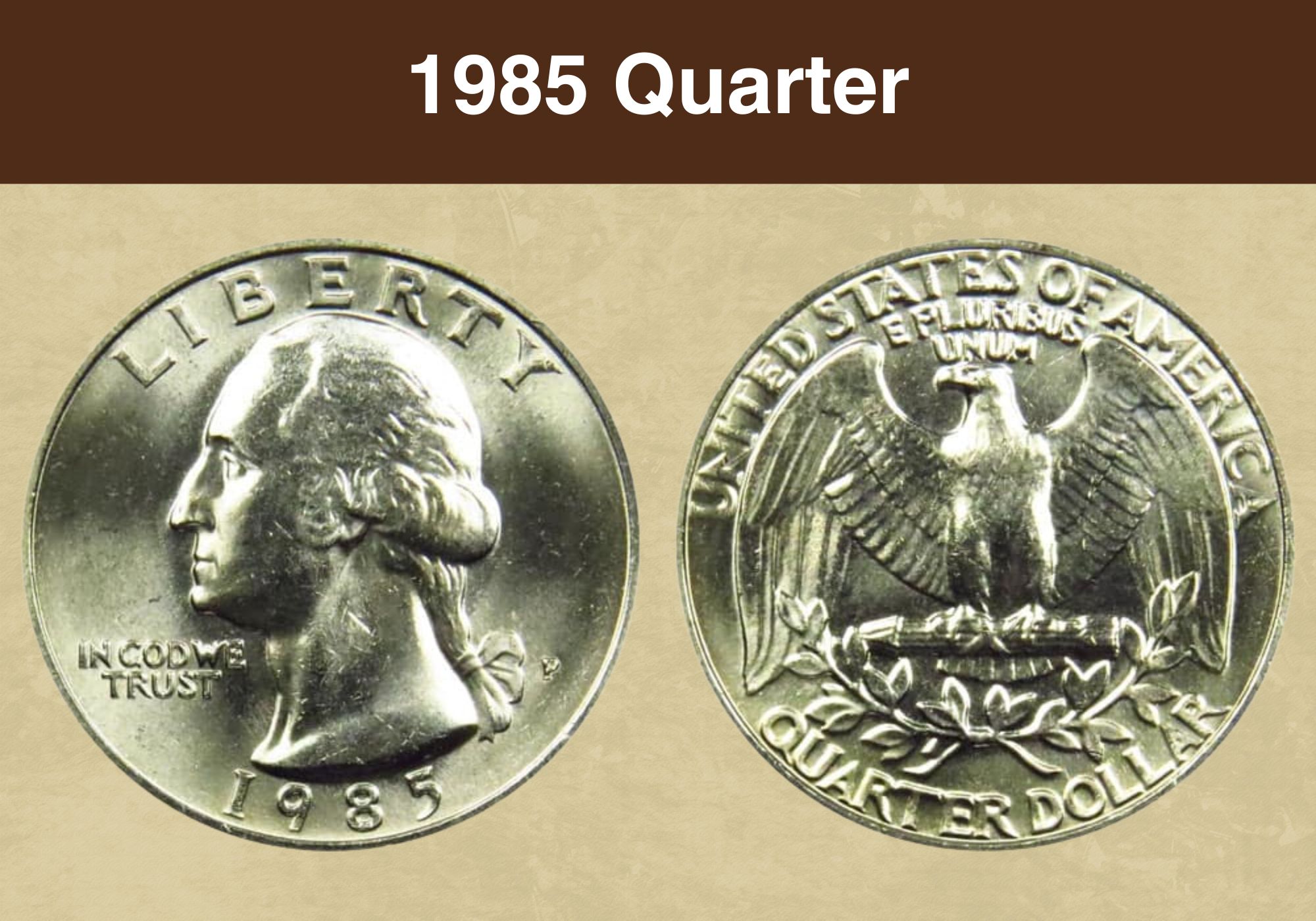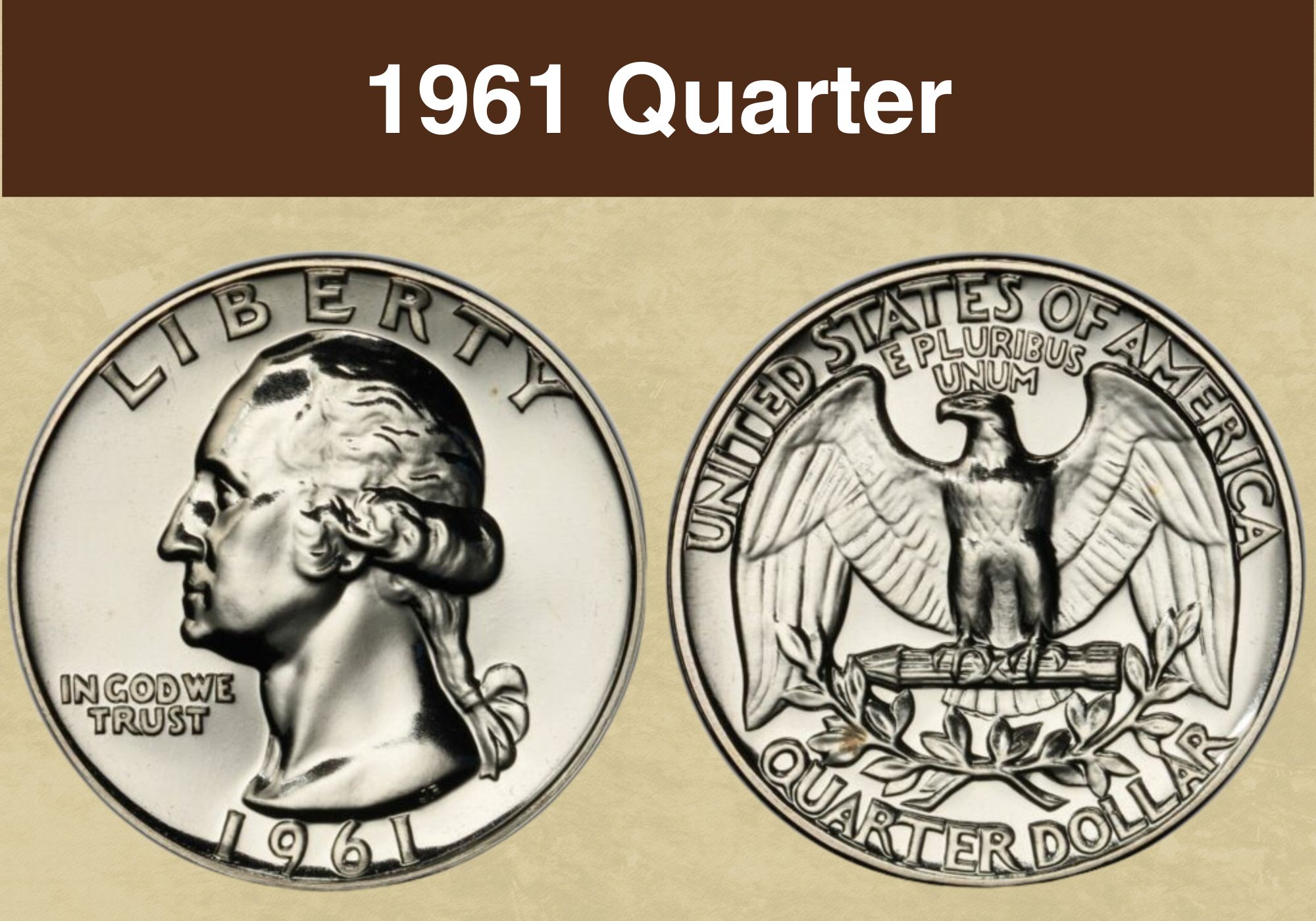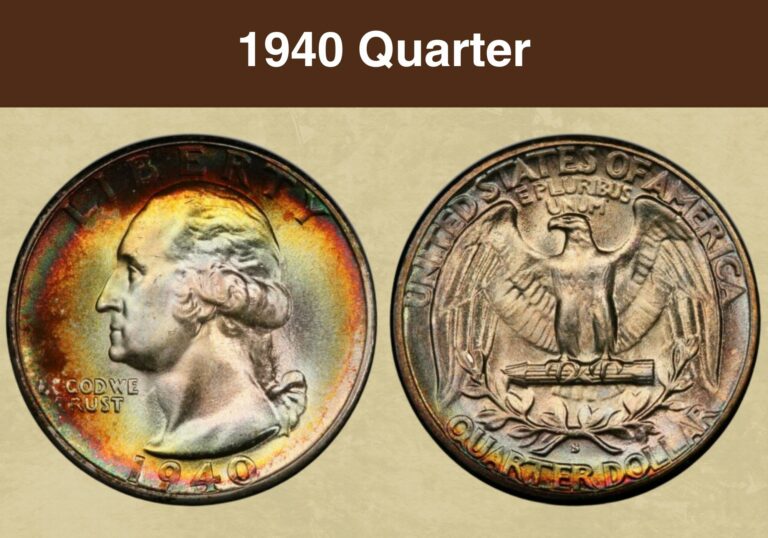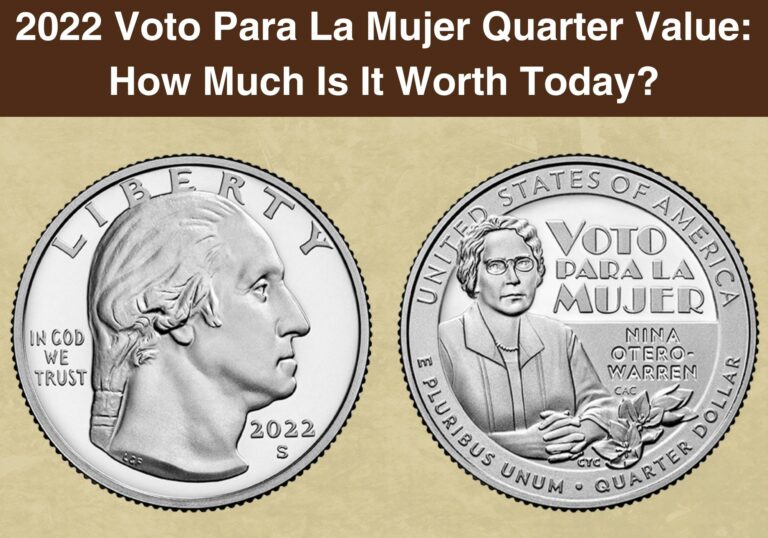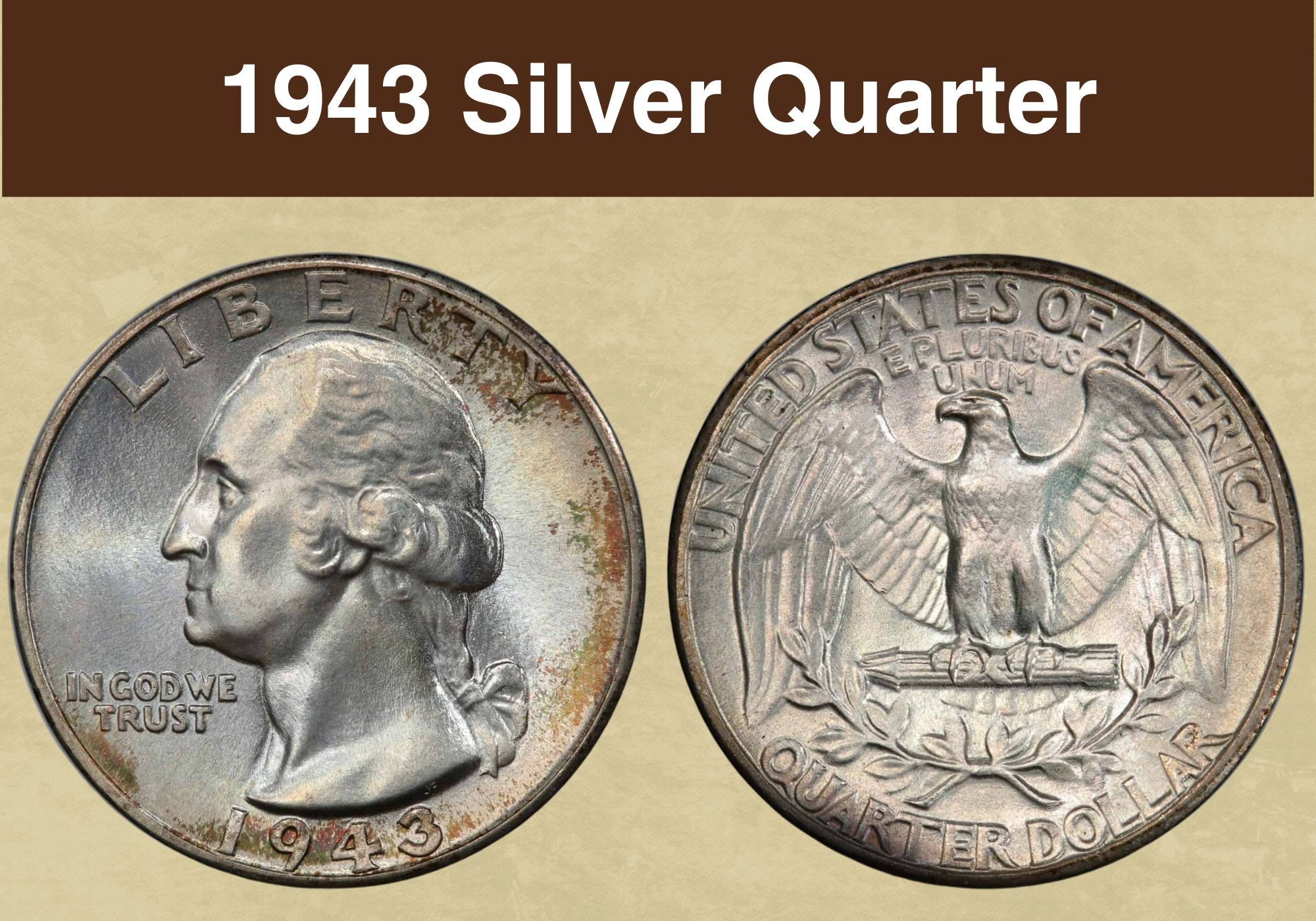
Coin Value Contents Table
The 1943 Silver Quarter holds a special place in the hearts of numismatists and history enthusiasts alike. Minted during the Second World War, a time of great turmoil in the world, this coin holds historical significance.
These coins are part of the Washington Quarters range, which was minted from the year 1932 to 1988. The 1943 Silver Quarter Value depends on various factors including its condition, grade, and rarity.
Within this guide, we will provide an overview of the 1943 silver quarter’s value, grading standards, and other necessary information that will help you make informed decisions when buying or selling this coin.
1943 Silver Quarter Value Chart |
||||
| Mint mark | Good | Extremely Fine | MS-60 | MS-66 |
| 1943 No Mint Mark Silver Quarter Value | $5.50 | $5.50 | $10 | $85 |
| 1943 D Mint Mark Silver Quarter Value | $8.50 | $15 | $27.50 | $95 |
| 1943 S Mint Mark Silver Quarter Value | $8.50 | $12.50 | $25 | $110 |
The US Mint produced three variations of the 1943 quarter: without a mint mark, with an S mint mark, and with a D mint mark. When present, the S and D marks are present on the reverse side of the quarter.
All three variations of the 1943 quarter were composed of 90% silver and 10% quarter, like all other coins of the Washington Quarters range that were struck in the years 1923-65. However, after 1965, the US Mint transitioned completely from silver to base metals.
There were two reasons behind this decision. One, silver was too expensive, and the price was constantly on the rise. The production price was more than the face value. Second, due to the rise in silver prices, people started hoarding silver coins.
To put an end to the hoarding issue and to combat the price rise, Congress went with the only viable solution at hand. In 1965, Congress passed the Coinage Act, thereby removing silver as a component of the US coins. In 1976, an exception to this Act was made when silver coins were struck again— for collectors only.
The 1943 Silver Quarter has reeded edges, with a fineness of 0.9 and a 24.3mm diameter. Weighing 6.25g, the melting value of the coin is calculated to be $4.54 as of April 2023. This value is derived from the current silver spot price of $24.98 per ounce.
The 1934 Quarter was designed by John Flanagan and features an image of George Washington on the obverse side. Above his head, the word LIBERTY is inscribed, and below it, the US motto: IN GOD WE TRUST. Under the image, you can find the number 1943— the year in which the coin was struck.
The reverse side depicts a heraldic eagle, symbolizing the power and strength of the country. In its claws, the bird holds arrows, which symbolize the readiness of the US to go to war. Underneath it are two olive branches, which symbolize peace.
Hence, the design holds great significance. The phrases “UNITED STATES OF AMERICA, “E PLURIBUS UNUM,” and “QUARTER DOLLAR” are also inscribed on this side.
Also read: Top 13 Most Valuable State Quarters Worth Money
1943 Silver Quarter Grading
The 1943 Silver Quarter is readily available in different conditions— from extremely worn to completely fresh, the latter being to the rarer end. The highest value is of uncirculated coins.
As mentioned earlier, uncirculated coins show no signs of abrasion from circulation. To check for this, look at any sign of wear from the cheeks. If there is a break of the delicate luster, the coin is showing signs of wear.
| # | Grade |
|---|---|
| 1 | Basal State-1 |
| 2 | Fair |
| 3 | Very Fair |
| 4, 5, 6 | Good |
| 7, 8, 10 | Very Good |
| 12, 15 | Fine |
| 20, 30 | Very Fine |
| 40 | Extremely Fine |
| 50 | About Uncirculated |
| 60 | Mint State |
| 65 | Mint State |
| 70 | Mint State |
Please check our grading guides to know your coin scale, It’s the necessary step to know the exact value of your coin.
Check out now: How to Grade Washington Quarter?
1943 Silver No Mint Mark Quarter Value
Philadelphia mint produced the variation without a mint mark, with the mintage quantity being 99,700,000.
The production for the 1943 Silver No Mint Mark Quarter stopped just before it reached the 100 million mark. Still, the coin is very common, even in MS 66 and MS 67 grades. However, a large amount of these coins fell in the MS 67 grades mostly because the toning was outstanding.
Also, due to the large mintage, wear and tear alongside production die issues are also common, even in the MS 67 grades. Therefore, when picking these coins out, it is not only important to look at the grade, but you must also inspect the specimen clearly for any issues.
As mentioned above, the 1943 Silver Quarter Value depends on various factors including grading. A quarter in a good condition will have the lowest value among the entire group because it will show the most signs of wear and tear.
Only the major details will be visible, the rest flattened. The top letters will have begun merging with the rim. In this condition, the value will be only as much as the silver content.
Next, in fine conditions, the coin will show signs of wear and tear, but less than the good condition one. The hair and curls of George Washington will be flattened, but the hair on the forehead will still be visible. The value for these coins will be more or less the same as the ones in good condition, but always on the upper bound.
After this are the extremely fine condition coins, which show minimal signs of wear. For this grade, the hair detail towards the top of George Washington’s head, cheeks, ear, and eye serves as the deal-breaker or maker. If the details are crisp, the coin will be classified among the extremely fine grade.
The grade with the highest value is the uncirculated one. This grade is described as one that was not touched before and is completely fresh— as if directly from the mint. The color of this one also corresponds with the fresh condition, i.e., is silver white or natural tones. Typically, these coins show absolute zero signs of wear.
The 1943 Silver No Mint Mark Quarter Value in the circulated condition is at least around the weight of silver in the coin, i.e. $5. The price remains more or less the same in extremely fine condition, too. In uncirculated condition, the same coin at an MS 60 grade, is worth $10.
The price increases to up to $85 for MS 66 grades but is still lesser than most of its counterparts in the Washington Series. The reason behind this is the large mintage quantity, widespread circulation, and the fact that these are only about 80 years old.
So, as per the NGC Price Guide, as of April 2023, a Washington Quarter from 1943 can be anywhere between $5 to $85. However, on the open market, the value of 1943 Silver No Mint Mark Quarter in pristine, uncirculated condition can go all the way up to $6500.
1943 Silver D Mint Mark Quarter Value
The 1943 Silver D Mint Mark Quarter has the same specifications as the Philadelphia variety— from design to designer, to weight, diameter, fineness, composition, edges, and melt value. However, it also has its set of differences.
This variety of the 1943 silver D mint mark quarter was minted in the Denver Mint and has a little D mark on the bottom of the reverse side. The Denver mint struck 16,095,600 of the 1943 quarters.
Unlike the Philadelphia Mint, the Denver Mint didn’t produce as many coins, so the quality was well-maintained. The coins were struck from properly managed dies.
Gem coins of MS 67 grades are far from scarce, and the ones graded at MS 66 are even more readily available. In extremely fine condition, the 1943 Silver D Mint Mark Quarter costs around $15. In uncirculated conditions, they are worth $95.
According to the NGC Price Guide as of today, the value of a 1943-D Quarter in circulated condition ranged between $8 to $25. On the other hand, in the open market, a 1943-D Silver Quarter in pristine and uncirculated condition can cost up to $9500.
1943 Silver S Mint Mark Quarter Value
Similar to its Denver Mint counterpart, the 1943 Silver S Mint Mark Quarter shares similarities with the Philadelphia one in terms of design, history, and structure. However, as the title suggests, these coins have an S mint mark, a symmetrical Serif S, on them and were minted in the San Francisco mint.
These are a little less rare than the ones minted in Denver. The San Francisco mint struck 21,700,000 coins, setting a record for its highest production of quarters until that year. The record stood until 1954— the year in which it stopped producing coins for circulation.
Mint State coins of the 1943-S variety are plentiful, and gems of grade MS 66 and MS 67 are readily available, too. There are a few semi-proof-like specimens as well, which have resulted from repolishing worn dies done to extend useful life.
Repolishing has in some cases revealed raised lines on the struck coins, and in others, it has barely caused any change.
For this variety, many error coins have been recorded up till now. These include double-die coins, but it has been prominent in only one of the recorded coins so far.
In extremely fine circulated condition, the 1943 S quarter costs $12.50. In uncirculated conditions, their worth may increase up to $35, and uncirculated ones in gem condition can also sell for as much as $55.
According to the NGC Price Guide, as of today, the value of a 1943 Silver S Mint Mark Quarter in circulated condition can range between $8.50 to $22.50. The same coin in uncirculated, pristine condition, can sell on the open market for as much as $10,000!
Also read: Top 16 Most Valuable Modern Quarters Worth Money
Rare 1943 Silver Quarter Error List
The 1943 Silver Quarters do not have a large range of identified errors, unlike some other Washington Quarters. However, the quantity of most error coins has been more. Nevertheless, error coins are still classified as rare because they are still a lot less scarce than the commonly available ones.
So far, a few error coins have been recorded in auctions and sold at really high prices.
1943 Silver Quarter Double Die Error
A double die error is when the markings overlap each other, and in the case of the 1943 quarter, it is found on the obverse side of the coins.
A few notable occurrences of double die error have been found in the 1943 Silver Quarter. But in two cases, the error has been very prominent: one from the Philadelphia mint and one from the San Francisco mint.
The 1943 no-mint mark double die error quarter is worth around $2,750 in circulation and in extremely fine condition. In uncirculated conditions, the value increases drastically and goes up to $5,500. For higher grades like MS 65, the price increases even further— it can go as high as $12,000!
In comparison, the 1943 S quarter double die error coin is not as valuable but still values more than its normal counterpart. In extremely fine condition, this coin can cost $200.
In uncirculated condition and MS 60 grade, the price doubles and goes up to $550. For MS 65 grade, the price doubles again and goes up to $1,650.
1943 Silver Quarter Repunched Mintmark Error
The second error on the list is the re-punched mint mark error, which occurs when the mint mark dies and hits the planchet two times. A few re-punched mintmark error coins have been recorded for the 1943-S quarters.
Also read: 17 Most Valuable Quarter Errors Worth Money
Where to Sell Your 1943 Silver Quarter ?
Now that you know the value of your coins, do you know where to sell those coins online easily? Don’t worry, I’ve compiled a list of these sites, including their introduction, pros, and cons.
Check out now: Best Places To Sell Coins Online (Pros & Cons)
1943 Silver Quarter FAQ
What is a 1943 silver quarter worth today?
Starting from $5, the 1943 quarter can go up to $110, depending on the grade, rarity, and condition. For rare coins, the worth of the 1943 silver quarter can shoot up to hundreds and thousands of dollars.
Is a 1943 quarter rare?
No, the 1943 quarter is readily available as the total mintage quantity was 137,495,600. The coins were widely circulated, so an MS 68 coin can be rare. Ultimately, errors, conditions, and grade help determine the rarity of a 1943 quarter.

